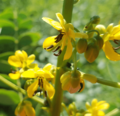Maryland senna facts for kids
Quick facts for kids Maryland senna |
|
|---|---|
 |
|
| Scientific classification | |
| Synonyms | |
|
Synonyms
|
Senna marilandica, also called the Maryland senna or Maryland wild senna, is a lovely flowering plant. It grows naturally in the United States. This plant blooms during the summer months. It can grow quite tall, sometimes reaching up to six feet high! It likes soil that is average to wet. You can find it from the southeastern U.S. all the way up to the southern Great Lakes region.
About Maryland Senna
The Maryland senna is a perennial plant. This means it lives for more than two years. It comes back year after year. It is known for its bright yellow flowers. These flowers often have black stamens, which are the parts that hold pollen. The plant's leaves are green and divided into many smaller leaflets.
Where It Grows
This plant is native to many parts of the United States. It grows well in the southeastern states. You can also find it in the southern Great Lakes area. It prefers places with enough moisture. This includes areas with average to wet soil. It often grows in fields, along roadsides, and in open woodlands.
A Home for Butterflies
Maryland senna is very important for certain butterflies. It acts as a "host plant" for their caterpillars. This means the caterpillars eat its leaves. It helps them grow and change into butterflies.
Some of the butterflies that use Maryland senna are:
- The cloudless sulphur (Phoebis sennae)
- The orange-barred sulphur (Phoebis philea)
- The sleepy orange (Eurema nicippe)
By planting Maryland senna, you can help these beautiful butterflies. It gives them a safe place to lay their eggs. It also provides food for their young.
Images for kids
-
Senna marilandica on the banks of the Cacapon River



